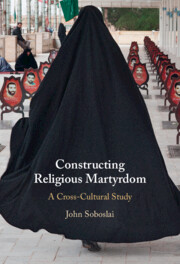Book contents
- Constructing Religious Martyrdom
- Constructing Religious Martyrdom
- Copyright page
- Dedication
- Contents
- Acknowledgments
- Abbreviations of Ancient Sources
- 1 Introduction
- 2 Executed Martyrs in Second-Century Christianity
- 3 The Human Bombs of Twentieth-Century Shi’i Islam
- 4 Sikh Martyr Imaginaries during World War I
- 5 Twenty-First-Century Tibetan Self-Immolators
- 6 Performances of Suffering
- 7 Witnesses to a Sovereign Imaginary
- Epilogue
- Bibliography
- Index
6 - Performances of Suffering
The Drama of Martyrdom
Published online by Cambridge University Press: 07 June 2024
- Constructing Religious Martyrdom
- Constructing Religious Martyrdom
- Copyright page
- Dedication
- Contents
- Acknowledgments
- Abbreviations of Ancient Sources
- 1 Introduction
- 2 Executed Martyrs in Second-Century Christianity
- 3 The Human Bombs of Twentieth-Century Shi’i Islam
- 4 Sikh Martyr Imaginaries during World War I
- 5 Twenty-First-Century Tibetan Self-Immolators
- 6 Performances of Suffering
- 7 Witnesses to a Sovereign Imaginary
- Epilogue
- Bibliography
- Index
Summary
Chapter 6 is the first to develop the new theory of martyrdom and draws together insights from case studies towards an understanding of martyrdom as a performance of suffering that enacts the truth of a sovereign imaginary. First, I analyze the similarities and differences regarding the practices of self-killing and introduce the concept of performance suffering to explain how martyrdom’s afflictions of the body are used to communicate a truth by a) seeking to directly influence the situation martyrs face, and b) making a symbolic statement about the nature of the crisis, the social collectives involved, and the hopes for an ideal world. I examine the settings wherein martyrs are produced, the scripts guiding their performances, the sacred models they reinscribe, and the audiences to whom martyrdom communicates. In doing so, I argue the present becomes aligned with a sacred past, creating an experience of living again in legendary times requiring legendary feats. As martyrdoms are seen to reiterate the deeds of sacred models, they are marked as possessing the highest character, lending their speech a greater impact through the form of truth-telling known as parrhēsia.
- Type
- Chapter
- Information
- Constructing Religious MartyrdomA Cross-Cultural Study, pp. 323 - 361Publisher: Cambridge University PressPrint publication year: 2024

